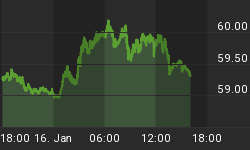Below is an extract from a commentary originally posted at www.speculative-investor.com on 14th July 2005.
The single biggest surprise to us over the past few years has been that inflation expectations have remained low. This, rather than the related low level of bond yields, is where the true conundrum lies.
Although inflation expectations can't be measured directly there are many ways to determine their trend and whether they are low or high. We'll discuss some of these ways a bit later, but first we'll quickly review some history.
Back in late 2001 and early 2002, when the CRB Index was trading below 200 and most people were very bearish on commodities, we persistently argued that the huge Fed-engineered inflation of the money supply that was in progress would lead to substantially higher commodity prices over the ensuing few years; and that once the signs of inflation became blatantly obvious in the commodity markets there'd be a serious decline in the bond market. At that time we speculated that the CRB Index moving above its 2000 peak of around 235 would probably be the 'point of recognition' for the bond market.
What actually happened, however, was that inflation expectations remained low and the bond market greeted each successive upside breakout in commodity prices with a yawn. There was the occasional inflation scare, but these were always short-lived.
As noted in our 11th July commentary, there are several explanations floating around as to why bond yields remain near generational lows despite the Fed's rate hikes and the widespread inflationary evidence. For example, the theory put forward by Richard Duncan is that the re-cycling of trade-deficit dollars by foreign central banks is mostly to blame for the failure of bond yields to rise. This is an explanation we broached at TSI during the second quarter of 2003, well before it became popularised on the internet, but while it had and continues to have some merit it sidesteps the main point: that inflation expectations have remained low. The demand for bonds stemming from central banks has certainly pushed bond yields lower than would otherwise have been the case, but if inflation expectations had risen sharply then even this official-sector demand could not have prevented long-term interest rates from surging.
Now, as mentioned at the beginning of this discussion it is not possible to directly measure inflation expectations so how do we really know they are low?
The answer is that the footprints of the 'inflation is destined to remain low for years to come' viewpoint can be observed in many different places. Here are a few examples.
1. Over the past few years the difference between the yield on a 10-year T-Note and the yield on a 10-year Inflation Protected Security has never been higher than 2.7%, which tells us that the average 10-year increase in the CPI forecast by the market has never been higher than 2.7%. The CPI has little to do with inflation because inflation is an increase in the supply of money, not an increase in the price of some arbitrary basket of goods, but the CPI forecast by the market has a lot to do with the expected EFFECTS of inflation.
2. Despite the 2000-2002 downturn, the average P/E ratio in the US stock market has stayed at a lofty level. Inflation expectations and P/E ratios are inversely correlated over the long-term, meaning that when investors expect higher inflation they demand a higher earnings yield (the earnings yield is the reciprocal of the P/E ratio). The S&P500 Index could therefore not be where it is today unless inflation expectations were very low.
3. Bill Gross, the manager of a $500B bond fund and a very influential participant in the bond market, recently forecast that 10-year T-Note yields would languish between 3.0% and 4.5% for the next 3-5 years due to persistently low inflation.
Based on Bill Gross's record he is clearly a very good money manager and someone who calls it the way he sees it. However, he's also someone whose views have rarely been far off the beaten track. For example, he recently turned bullish on US bonds due to an epiphany that inflation was going to be low for years to come, but in the midst of the little inflation scare that occurred during the second and third quarters of last year he was bearish on bonds due to the likelihood of much higher inflation. Also, at the beginning of this year he wrote that investors should favour German government bonds over US bonds because the dollar was clearly going to continue its decline. In other words, Mr Gross's macro views have generally been in line with the consensus.
4. The following charts show that the gold/CRB and NEM/PD ratios are at multi-year lows, which would almost certainly not be the case unless inflation expectations were very low. The reason is that the prices of gold and gold stocks will tend to attract premiums over the prices of most other commodities and commodity-related stocks when investors perceive inflation to be a big threat. However, when most people perceive price rises to be the result of real economic growth, rather than an effect of inflation, gold-related investments will tend to under-perform. Taken alongside everything else there is little doubt that the relatively poor performances of gold and gold stocks are associated with the low level of inflation expectations.


We think the markets are under-estimating both the commitment and the ability of the Fed to inflate, so from our perspective the upside risk in bond yields remains much greater than the downside risk as far as the coming 1-2 years are concerned. However, with the Fed in tightening mode and commodity prices probably about to head lower we are entering a 3-6 month period when inflation expectations could very well become even more depressed. More depressed, that is, until the markets sense that the next round of central-bank-sponsored money creation is about to start.
















